In this article, I would like to give you some tips on photographing dragonflies with minimal gear. I’m an amateur landscape and wildlife photographer from France. I graduated in ecology (biodiversity management and biology of conservation) last year before I decided to leave to New Zealand for a one-year trip. I discovered landscape and astrophotography in this beautiful country, but I feel like I sometimes need to get back to wildlife photography which is what I was first interested in. Because of my studies, I spent a lot of time in the field working on insects and especially dragonflies, learning how they live, observing their behavior and understanding the importance of their preservation.
Their diversity of shape, color and behavior make them fascinating to photograph but also to study. Because of their life cycle, they are related to water, the majority of them living in wetlands. These ecosystems are extremely important to protect mostly because of the services they provide to us (half of the world’s population rely on these ecosystems for their water needs) but also because they host a tremendous diversity of species, vegetal or animal.
Like most of wildlife photography, knowing the animal you want to shoot is as important as knowing how to take a picture of it. I will try to cover most of the information you need to know about dragonflies so you don’t miss an opportunity to photograph them. The second thing I will insist on is composition, how to place your subject in the frame and use the elements of its habitat. And last but not least, taking pictures of dragonflies requires you to understand and master your gear and the settings you need to use. However, I won’t go into much detail on this here as you can find a way more complete information by combining the different reviews and wildlife guides at Photography Life. For a start, check out the photography tips page.
Some of the ideas or tips I will give are also already explained in the macro photography tutorial, which is why I will skip over some technical info as it is well described already.
1) Know Dragonfly Behavior
Before you get out there with your boots or waders, you need to have some basic knowledge of dragonfly behavior, depending on which kind of picture you want. If your purpose is to shoot landed dragonflies, your best bet is to wake up early or wait for the end of the day. These insects are mostly active when the sun is already up and the temperature is rising, flying frantically around their territory. At dawn or dusk, it’s a different story! You can approach them way easier and get some nice macro shots. Plus, the light is usually better at that time, and you can sometimes get a nice dew on the dragonfly early in the morning! The only hard thing will be to find them in the vegetation though.
The following picture of an Emerald dragonfly (Lestes sponsa) was taken just before the sun disappeared at the horizon, when it started to be cold and all of the damselflies stopped flying around the peat bog. On a side note, these damselflies have a funny behavior which consists of turning around the grass they landed on, always facing you, like it was trying to hide behind it…
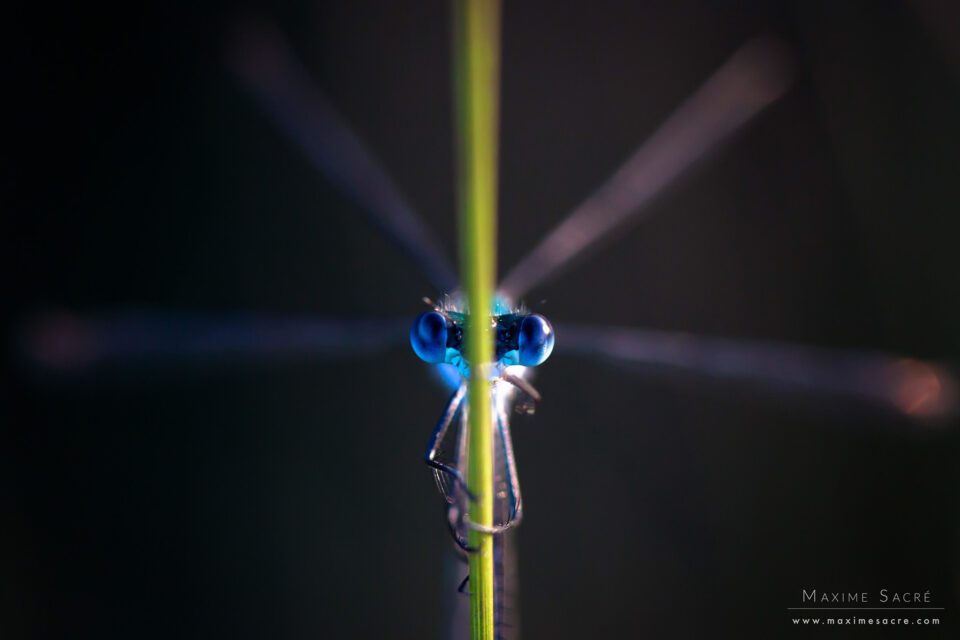
Like I said before, dragonflies are mostly active when the sun is out. So what about a cloudy or rainy day? You guessed it, they usually don’t fly much. That’s indeed another way to get easily close to them and practice your macro skills! I got a shot of this Banded demoiselle (Calopteryx splendens) on a cloudy day but the light isn’t as great as during a sunrise or sunset:
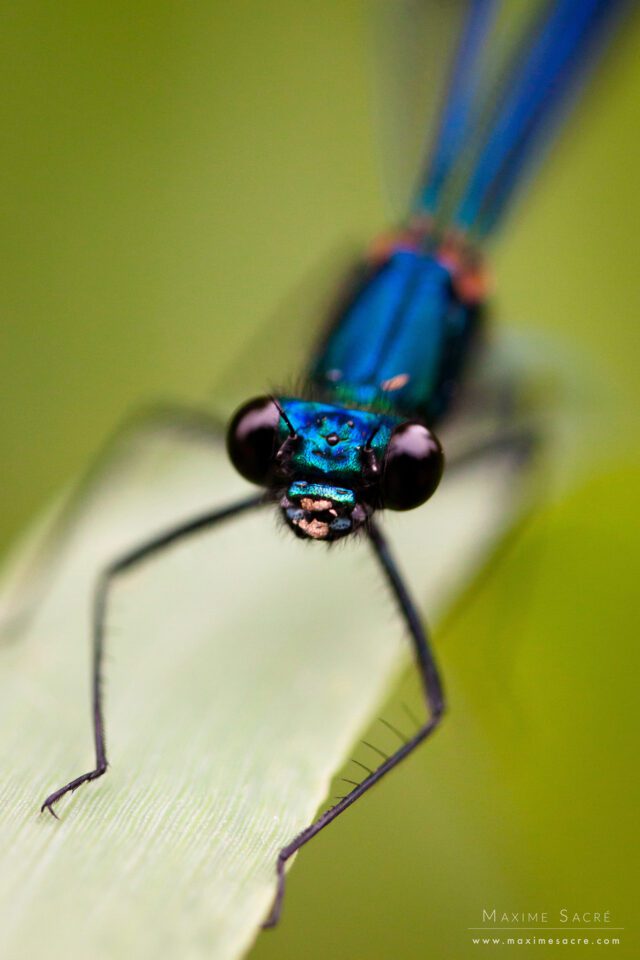
Of course, you can also try to approach a landed dragonfly anytime during the day, even if it’s sunny. It takes time though; you can’t expect to get close if you move toward or away from them, but I won’t go into details (see the macro photography tutorial link above). They also tend to be easier to approach while they’re eating, you’ll have to notice it though, which can be really hard considering the small size of most of their preys… Or not: look at this greedy Blue-tailed damselfly (Ischnura elegans)!
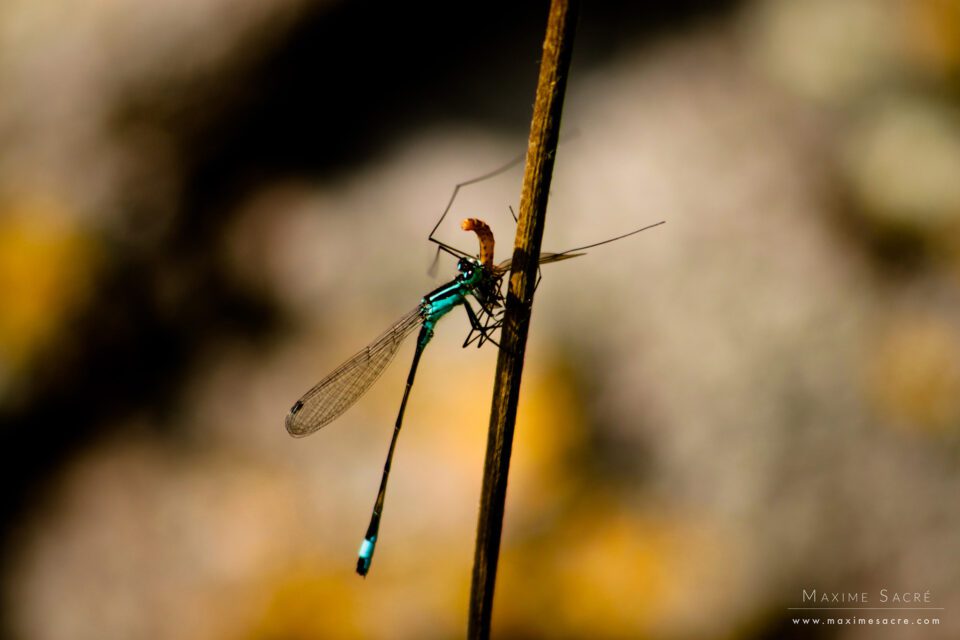
Having a picture of a landed dragonfly is fine, but capturing it while flying is usually way more challenging and rewarding! The good thing is that their flight is predictable most of the time.
Let’s start with males. Their preferred activity of they day is to fly around and patrol their territory, chasing every other challenger who might want to steal their spot. If you look carefully, you’ll see that while they are patrolling, they often follow the same route. You can then start to think about your composition in your picture (we’ll get back to that later) and work on what could make your photo stand out. That’s exactly what happened when I took this shot of this White-faced darter (Leucorrhinia dubia), I stood there looking at the path this male followed, then visualized how I could include it with a background. I found an interesting shape formed by the shadow of the vegetation (reminding this idea of a path), waited for the dragonfly to appear in the frame and shot, hoping for the dragonfly to be there!
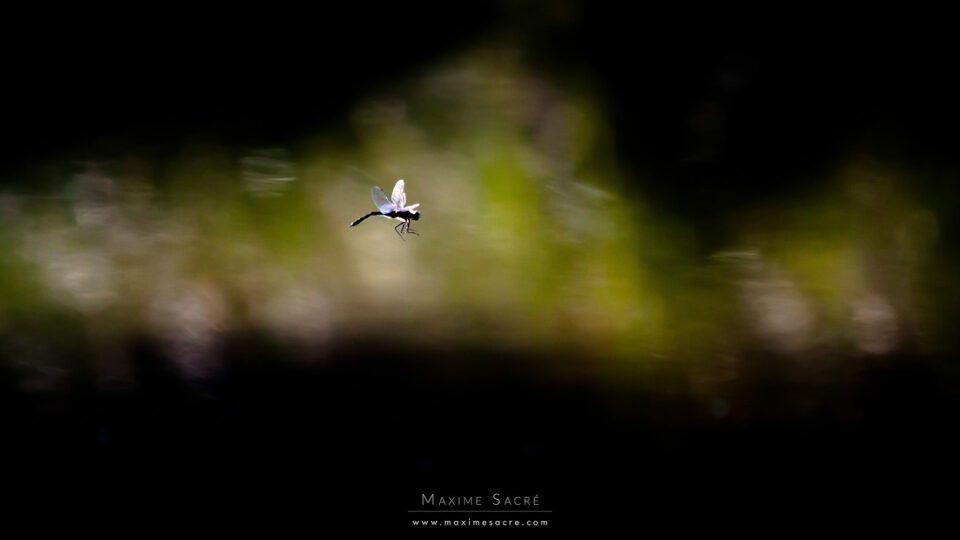
Another thing dragonflies love to do is hovering (and they’re pretty good at it!). It happens often when you’re on their territory, the male being probably curious of your presence and sometimes staying a few seconds facing you, waiting for you to capture the instant. And don’t worry, if you miss the opportunity, it will probably come back by the same route and stop on the same spot wondering again what you’re doing there. Here’s a good example with this Yellow-spotted emerald (Somatochlora flavomaculata) which stayed hovering for a few seconds, doing this more than 10 times which allowed me to get the picture I wanted.
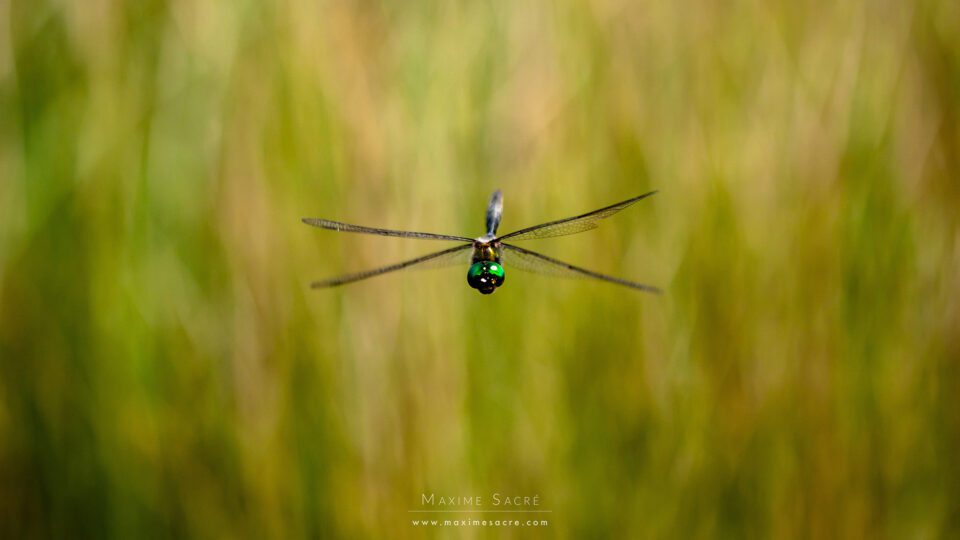
Enough with the males, what about the females? Sadly, for us photographers, female dragonflies are less colorful than males, simply because they don’t need to be as attractive as males and, because they give life, they’re more precious and absolutely need to survive until they lay their eggs. That’s why they also often stay hidden in the vegetation. But at one point they have to get out from their hide and fly to an open field.
Depending on the species/family, some dragonflies lay eggs into the stem of plants, deep into the mud and sediments of a resurgence, on a submerged plant or at the surface of the water while hovering. Yes, the last one looks clearly the most photogenic way! Again, here’s a picture of a White-faced darter, but this time with a female, doing this acrobatic egg-laying:
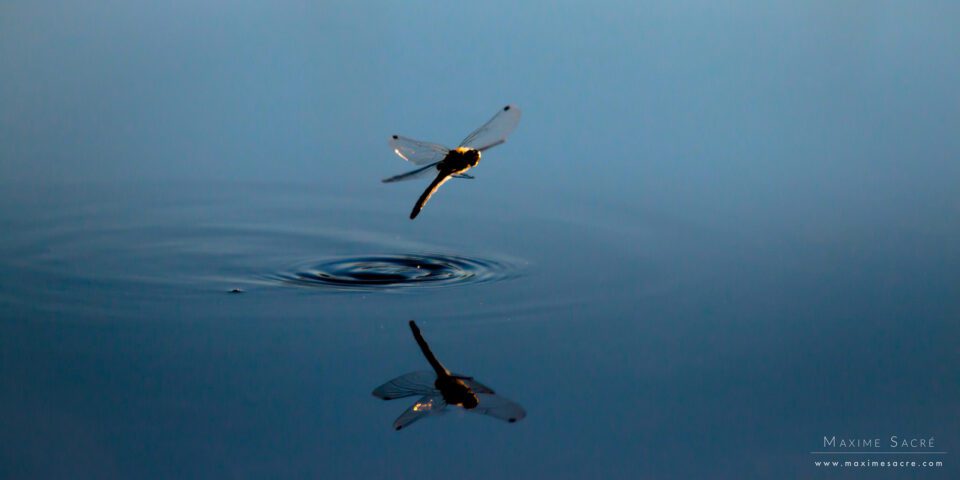
There’s also a technique that works for both males and females: while they hunt, they usually come back over and over to the same perch where they can eat their preys and be ready to take off to catch their next meal. You can then focus on the perch and wait for the dragonfly to land (it’s way harder to snap them when they take off as there’s almost no way to know when it’s going to happen). That’s what I did with this Ruddy darter (Sympetrum sanguineum). I just watched it fly and when I saw it coming back to its perch, so I started to shoot away!
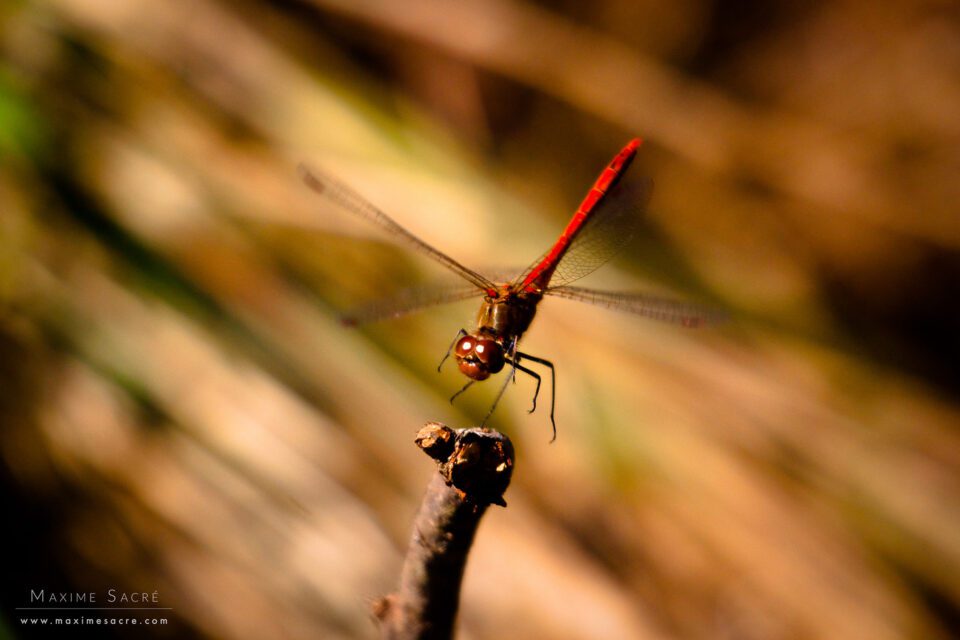
The last thing I would think of is related to their life cycle. The larva of the dragonfly lives in the water and then decide to emerge for its adult life when the time has come. This short and critical moment of their life can lead to beautiful pictures, painting one of the most interesting transformation in the insect life: the metamorphosis (which isn’t really complete for dragonflies). It happens usually in the morning, hidden somewhere to the view of potential predators, making it often hard to spot. Look down on plants close to the water or on the trunk of trees and you might see shining wings, freshly taken out from its last molt. I spotted this Brilland emerald (Somatochlora metallica) still hanging to its exuviae (the remains of its exoskeleton from its molt). You can notice that one of its wings isn’t deployed as expected, leaving this dragonfly flightless, to its own fate:
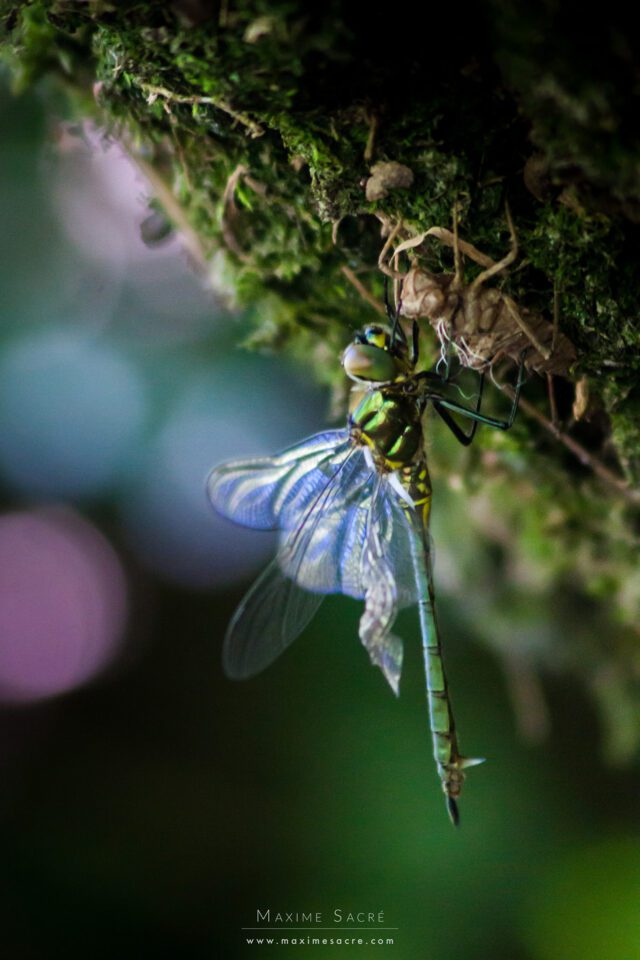
2) Composition
Now that you’re thinking as a dragonfly, you can start thinking as a photographer! Everything around the dragonfly itself is as important as the central subject of your picture. As it is the case for general macro photography, you should pay attention to the background. You can choose to keep it simple, so the eye isn’t attracted by any background element or on the contrary, use these distracting elements to reinforce your composition.
The aquatic environment is quite interesting for that; it offers to your creativity a perfect playground. The best example that comes in my mind is the water reflection, either of the dragonfly (see the female White-faced darter I pictured before) or any other element of its habitat. The vegetation on a riverbank can be used to create something different, to echo or remind the shape or the silhouette of your subject. That’s what I tried to achieve with this picture of these two Emerald dragonflies (Lestes sponsa), using the reflection of two pine trees far back on the land:
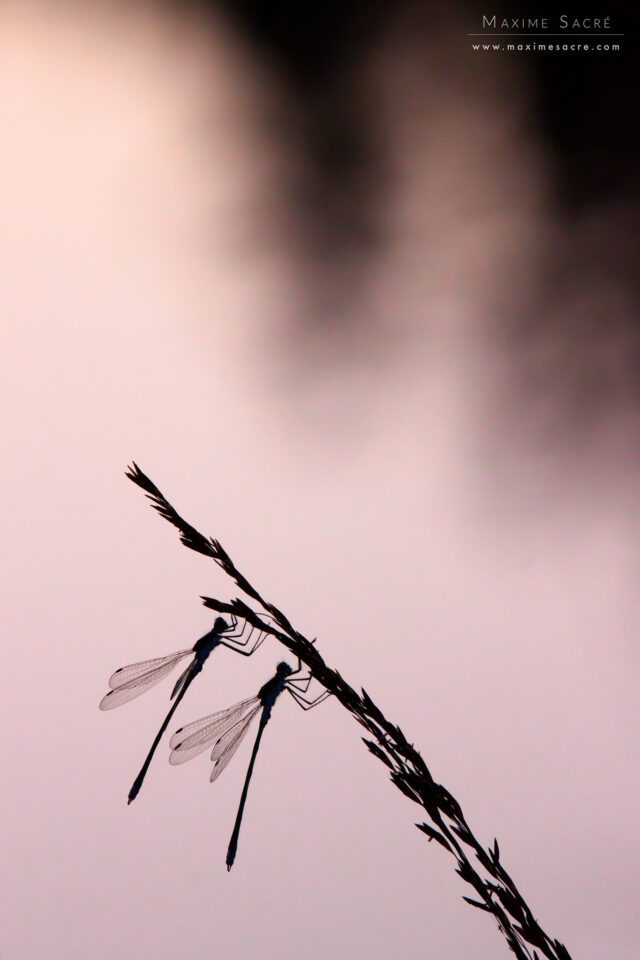
Besides the shapes, you can also play with the strong colors of some species, either to be in harmony or contrast with the background color. The light is also crucial if you want it to match with your subject. The first picture, of a Yellow-winged darter (Sympetrum flaveolum) shows this idea, with the sun rays piercing through the grass at the end of the day:
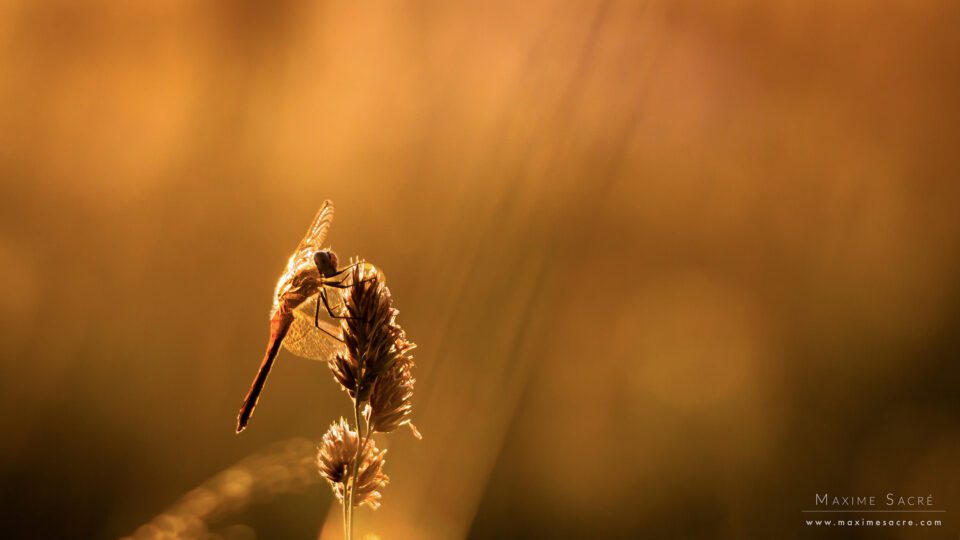
On the other hand, this Red-veined darter (Sympetrum fonscolombii) contrasts with its bright red body and the dark green background:
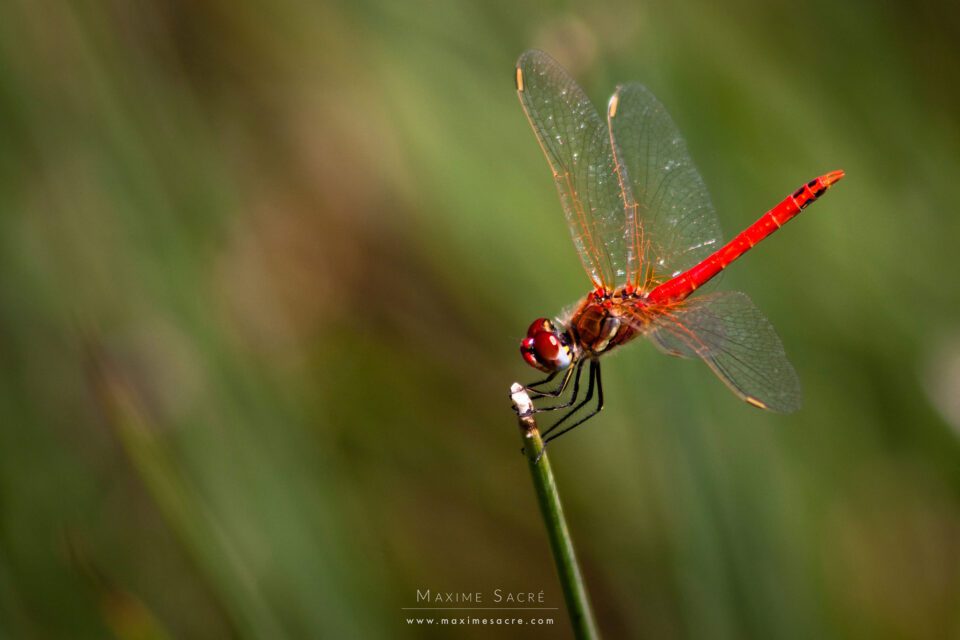
Most of my pictures are taken a few meters away from the dragonflies because I usually prefer to include these insects into their habitat and leave an important space for the background. I also sometimes like to shoot through the vegetation to make the dragonfly belong even more to its environment. Here’s an example with this Banded demoiselle (Calopteryx splendens):
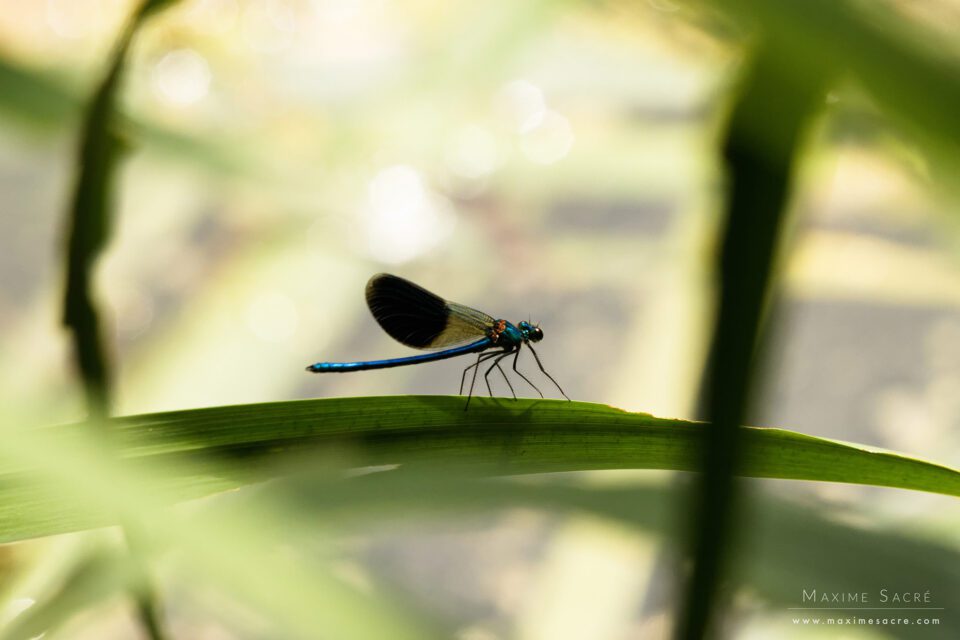
However, nothing prevents you to get closer if you have the chance to, and insist on details. Macro photography can be a useful tool especially if you want to reveal the complex structures of their bodies, mostly their head and wings.
3) Gear and Settings
I would like to end this article by talking a little bit about the gear and settings I often use and some recommendations related to my experience. I can’t really give you a review on which camera/lens you should use, considering your budget, simply because I have used pretty much the same gear for almost a decade. However, when you go in the field I would recommend to always take a telephoto and macro lens with you. It offers a lot more versatility and allows you to be more creative. Depending on the moment of the day and the weather, you can start shooting with your telephoto and switch to your macro lens when you have the opportunity to get closer. And if you’re not only focused on dragonflies, your telephoto will always be useful for bird photography!
As for the settings, you probably won’t learn anything about what I’m going to say but:
– If you want to get a picture of a dragonfly in flight with sharp wings, I would say to setup your shutter speed to at least 1/3200 or even more if you don’t mind getting your ISO high, depending on the light (you will also want to open your lens’s aperture as wide as possible).
– If the dragonfly is in landed position, just set the shutter speed so you can avoid any blur from your camera shake (see reciprocal rule). Your aperture will depend on the depth of field you are looking for, if you want it small, then open your lens’s aperture, but it can sometimes be useful to stop down the aperture so your subject can be entirely sharp (in the case of macro photography, you’ll mostly have to use a flash for that, see the Depth of Field part in the macro photography tutorial for more information.
And…That’s all for me! I hope these tips based on my experience will help you and give you some ideas for your next dragonfly photography session. As you can see there’s no need for expensive gear (I still use my Canon 500D and Sigma 120-400mm f/4.5-5.6 for most of my wildlife pictures) to snap these lovely insects. The most important thing and advise I would give to beginners, is to be patient while observing where and how dragonflies live, learn about their habits so you can anticipate their movements and general behavior. Then, you’ll be able to start thinking about your composition and add your creativity to your pictures.
For dragonfly lovers, you can check all of my pictures here.
If you have any questions I would be happy to answer them in the comment section!
This guest post was contributed by Maxime Sacré. You can see more of his work on his website.